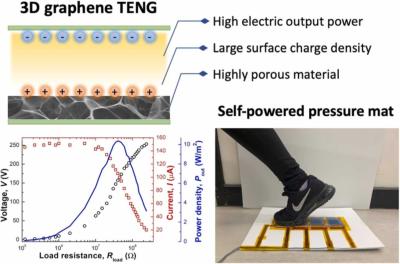Researchers from the University of the West of Scotland (UWS), in collaboration with Integrated Graphene, have examined the potential of three-dimensional graphene (3DG) foam (Gii) as an active layer in triboelectric nanogenerators (TENGs) and as an energy harvesting power source for autonomous sensors.
The research showed that the force of a human footprint on a pressure-sensitive mat equipped with Gii-TENG sensors can produce enough energy to anonymously keep track of people entering or leaving a room.
“Through our work with Integrated Graphene, we have proven that using Gii-material – an advanced type of three-dimensional graphene (3DG) foam – as an active layer in triboelectric nanogenerators can work as a reliable and cost-effective energy-harvesting power source for autonomous sensors and electronics,” said Dr. Carlos Garcia Nuñez from UWS. “This discovery has enormous potential for the booming global Internet of Things industry.”
As well as monitoring building occupancy, the mats could help to optimize energy resources by controlling room temperature as people enter and exit, or to inform carbon dioxide monitoring.
TENGs have been investigated as a technique for converting mechanical energy into electrical energy for about 20 years. Efforts to develop commercially viable devices have been hampered by low durability, limited energy output and inefficiency, however.
“The addition of Gii to TENG has opened up a whole new world of possibilities due to its unique properties, including high surface area, porosity, light weight, and superior electrical properties,” claimed Integrated Graphene.
Other solutions could include self-powered wearable biosensors for early diagnosis of health conditions including cardiovascular disease, gout and diabetes, or devices that harvest mechanical energy from the movement of cars and pedestrians.
“With the number of IoT devices interlinked worldwide forecast to reach 100bn by 2030, there is a clear need for new sustainable energy sources and technologies which can meet the power demand from our reliance on technology,” said Marco Caffio, CSO of Integrated Graphene.
